Lat Hyundai Grand i10 2015 Owner's Manual
[x] Cancel search | Manufacturer: HYUNDAI, Model Year: 2015, Model line: Grand i10, Model: Hyundai Grand i10 2015Pages: 343, PDF Size: 29.47 MB
Page 5 of 343
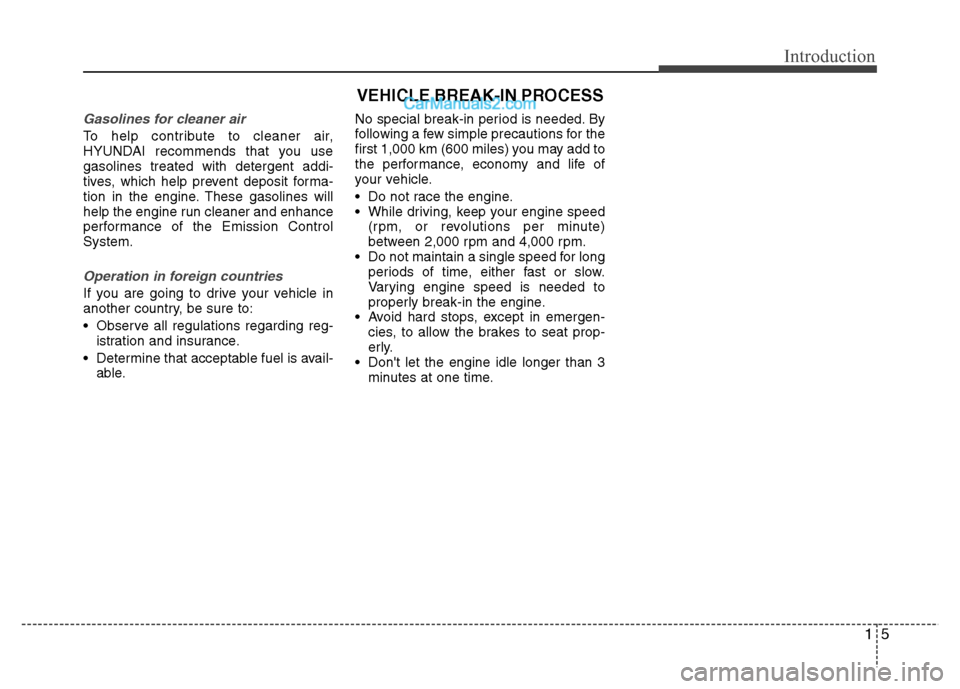
15
Introduction
Gasolines for cleaner air
To help contribute to cleaner air,
HYUNDAI recommends that you usegasolines treated with detergent addi-
tives, which help prevent deposit forma-
tion in the engine. These gasolines will
help the engine run cleaner and enhance
performance of the Emission ControlSystem.
Operation in foreign countries
If you are going to drive your vehicle in
another country, be sure to:
Observe all regulations regarding reg-istration and insurance.
Determine that acceptable fuel is avail- able. No special break-in period is needed. By
following a few simple precautions for the
first 1,000 km (600 miles) you may add to
the performance, economy and life of
your vehicle.
Do not race the engine.
While driving, keep your engine speed
(rpm, or revolutions per minute)
between 2,000 rpm and 4,000 rpm.
Do not maintain a single speed for long periods of time, either fast or slow.
Varying engine speed is needed to
properly break-in the engine.
Avoid hard stops, except in emergen- cies, to allow the brakes to seat prop-
erly.
Don't let the engine idle longer than 3 minutes at one time.
VEHICLE BREAK-IN PROCESS
Page 20 of 343
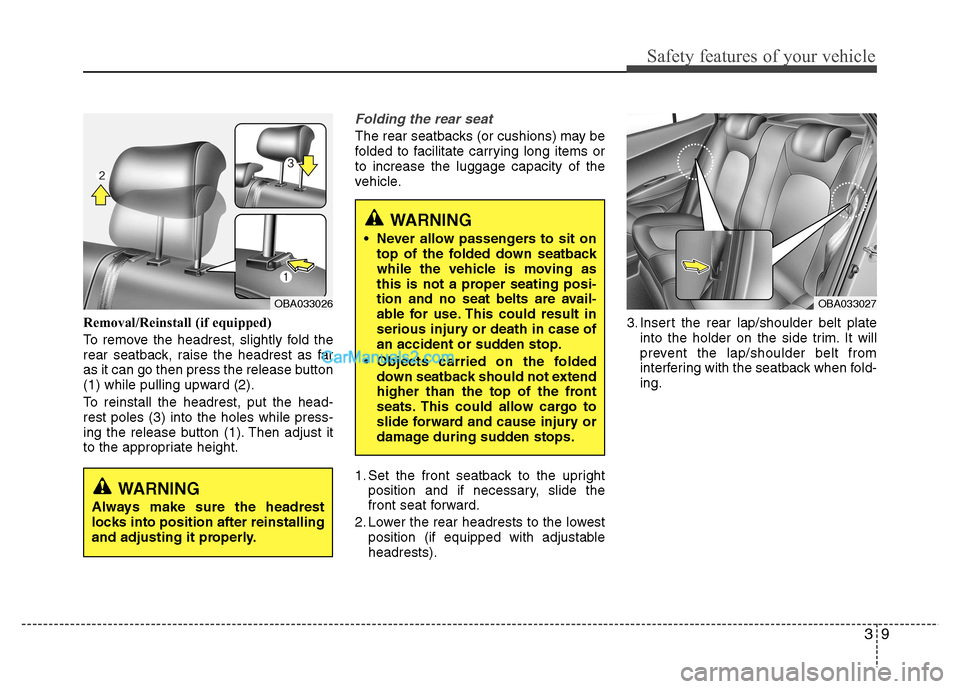
39
Safety features of your vehicle
Removal/Reinstall (if equipped)
To remove the headrest, slightly fold the
rear seatback, raise the headrest as far
as it can go then press the release button
(1) while pulling upward (2).
To reinstall the headrest, put the head- rest poles (3) into the holes while press-
ing the release button (1). Then adjust it
to the appropriate height.
Folding the rear seat
The rear seatbacks (or cushions) may be
folded to facilitate carrying long items orto increase the luggage capacity of the
vehicle.
1. Set the front seatback to the uprightposition and if necessary, slide the
front seat forward.
2. Lower the rear headrests to the lowest position (if equipped with adjustable headrests). 3. Insert the rear lap/shoulder belt plate
into the holder on the side trim. It will
prevent the lap/shoulder belt from
interfering with the seatback when fold-ing.
WARNING
Never allow passengers to sit on top of the folded down seatback
while the vehicle is moving as
this is not a proper seating posi-
tion and no seat belts are avail-
able for use. This could result in
serious injury or death in case of
an accident or sudden stop.
Objects carried on the folded down seatback should not extend
higher than the top of the front
seats. This could allow cargo to
slide forward and cause injury or
damage during sudden stops.
OBA033026OBA033027
WARNING
Always make sure the headrest
locks into position after reinstalling
and adjusting it properly.
Page 32 of 343

321
Safety system of your vehicle
CHILD RESTRAINT SYSTEM (CRS)
Children under age 13 must always ride
in the rear seats and must always be
properly restrained to minimize the risk of
injury in an accident, sudden stop or sud-
den maneuver. According to accident
statistics, children are safer when proper-
ly restrained in the rear seats than in the
front seat. Even with air bags, children
can be seriously injured or killed.
Children too large for a child restraint
must use the seat belts provided. Most countries have child restraint laws
which require children to travel in
approved child restraint devices. The
laws governing the age or height/weight
restrictions at which seat belts can be
used instead of child restraints differs
among countries, so you should be
aware of the specific requirements in
your country, and where you are travel-ling.
Child restraint systems must be properly
placed and installed in the rear seat. You
must use a commercially available child
restraint system that meets the require-
ments of the Safety Standards of your
country.
Child restraint systems are generally
designed to be secured in a vehicle seat
by lap belt or the lap belt portion of alap/shoulder belt in the rear seats of the
vehicle.
Child Restraint System (CRS)
Infants and younger children must be
restrained in an appropriate rear-facing
or forward-facing CRS that has first been
properly secured to the rear seat of the
vehicle. Read and comply with the
instructions for installation and use pro-
vided by the manufacturer of the child
restraint.WARNING
Always properly restrain children in
the rear seats of the vehicle.
Children of all ages are safer when
restrained in the rear seat. A child
riding in the front passenger seat
can be forcefully struck by an inflat-
ing air bag resulting in SERIOUS
INJURY or DEATH.
WARNING
An improperly secured child restraint can increase the risk of
SERIOUS INJURY or DEATH in an
accident. Always take the following
precautions when using a childrestraint system:
NEVER install a child or infant restraint in the front passenger’s seat.
Always properly secure the child restraint to a rear seat of the vehi-
cle.
Always follow the child restraint system manufacturer’s instruc-
tions for installation and use.
(Continued)
Page 33 of 343

Safety system of your vehicle
22
3
Selecting a Child Restraint System (CRS)
When selecting a CRS for your child,
always:
Make sure the CRS has a label certify-
ing that it meets applicable Safety
Standards of your country.
Select a child restraint system based on your child’s height and weight. The
required label or the instructions for
use typically provide this information.
Select a child restraint system that fits the vehicle seating position where itwill be used.
Read and comply with the warnings and instructions for installation and use
provided with the child restraint system.Child restraint system types
There are three main types of child
restraint systems: rear-facing seats, for-
ward-facing seats, and booster seats.
They are classified according to the
child’s age, height and weight.
Rear-facing child seats
WARNING
NEVER install a child or infant
restraint in the front passenger’sseat.
Placing a rear-facing child restraint
in the front seat can result in SERI-
OUS INJURY or DEATH if the child
restraint is struck by an inflating air
bag.
(Continued)
Always properly restrain your child in the child restraint.
Do not use an infant carrier or a child safety seat that "hooks“ over
a seatback, it may not provide ade-
quate protection in an accident.
After an accident, we recommend a HYUNDAI dealer check the child
restraint system, seat belts,
ISOFIX lower anchorages and top-
tether anchorages.
Page 36 of 343
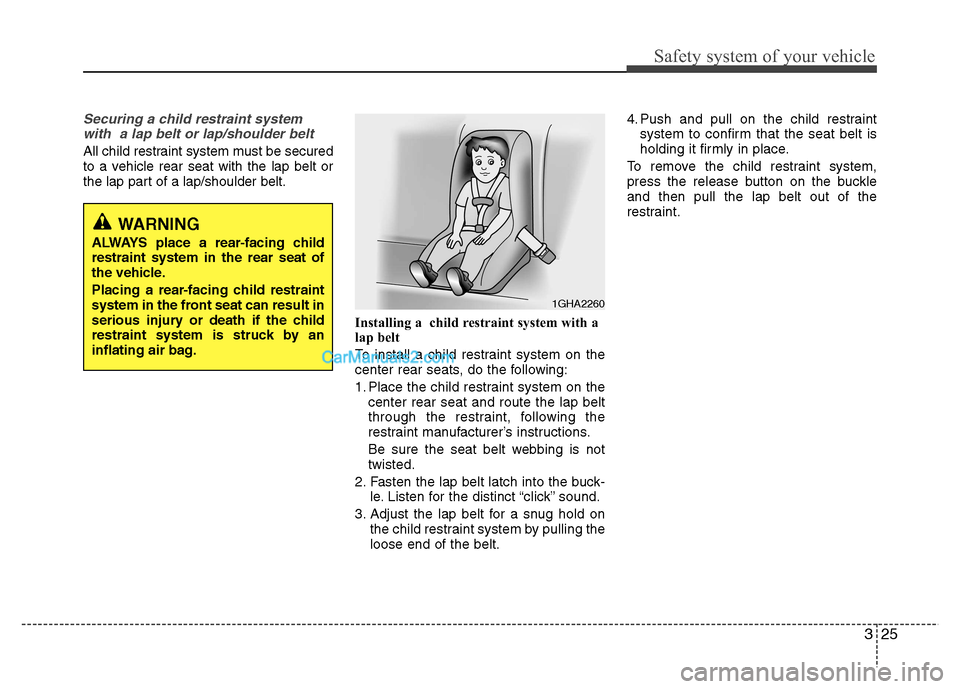
325
Safety system of your vehicle
Securing a child restraint systemwith a lap belt or lap/shoulder belt
All child restraint system must be secured
to a vehicle rear seat with the lap belt or
the lap part of a lap/shoulder belt.
Installing a child restraint system with a
lap belt
To install a child restraint system on the
center rear seats, do the following:
1. Place the child restraint system on thecenter rear seat and route the lap belt
through the restraint, following the
restraint manufacturer’s instructions.
Be sure the seat belt webbing is not twisted.
2. Fasten the lap belt latch into the buck- le. Listen for the distinct “click” sound.
3. Adjust the lap belt for a snug hold on the child restraint system by pulling theloose end of the belt. 4. Push and pull on the child restraint
system to confirm that the seat belt is
holding it firmly in place.
To remove the child restraint system,
press the release button on the buckleand then pull the lap belt out of the
restraint.
WARNING
ALWAYS place a rear-facing child restraint system in the rear seat of
the vehicle.
Placing a rear-facing child restraint
system in the front seat can result in
serious injury or death if the child
restraint system is struck by an
inflating air bag.
1GHA2260
Page 37 of 343

Safety system of your vehicle
26
3
Installing a child restraint system with a
lap/shoulder belt
To install a child restraint system on the
rear seats, do the following:
1. Place the child restraint system on a
rear seat and route the lap/shoulder
belt around or through the restraint, fol-
lowing the restraint manufacturer’s
instructions.
Be sure the seat belt webbing is not twisted. 2. Fasten the lap/shoulder belt latch into
the buckle. Listen for the distinct “click”sound.
✽✽ NOTICE
Position the release button so that it is
easy to access in case of an emergency.
3. Remove as much slack from the belt as possible by pushing down on the
child restraint system while feeding the
shoulder belt back into the retractor.
4. Push and pull on the child restraint system to confirm that the seat belt is
holding it firmly in place.
To remove the child restraint system,
press the release button on the buckleand then pull the lap/shoulder belt out of
the restraint and allow the seat belt to
retract fully.
OEN036104E2MS103005OEN036101
Page 40 of 343

329
Safety system of your vehicle
The front air bags are designed to sup-
plement the three-point seat belts. For
these air bags to provide protection, the
seat belts must be worn at all times when
driving.
You can be severely injured or killed in an
accident if you are not wearing a seat
belt. Air bags are designed to supple-
ment seat belts, but do not replace them.
Also, air bags are not designed to deploy
in every collision. In some accidents, the
seat belts are the only restraint protect-
ing you.
WARNING- AIR BAG SAFETY PRECAUTIONS
ALWAYS use seat belts and child restraints - every trip, every time, every- one! Even with air bags, you can be seriously injured or killed in a collision
if you are improperly belted or not wearing your seat belt when the air baginflates.
NEVER place a child in any child restraint or booster seat in the front pas- senger seat. An inflating air bag could forcefully strike the infant or childcausing serious or fatal injuries.
ABC - Always Buckle Children under age 13 in the back seat. It is the safest place for children of any age to ride. If a child age 13 or older must be seat-
ed in the front seat, he or she must be properly belted and the seat should
be moved as far back as possible.
All occupants should sit upright with the seatback in an upright position, centered on the seat cushion with their seat belt on, legs comfortably
extended and their feet on the floor until the vehicle is parked and the
engine is turned off. If an occupant is out of position during an accident,
the rapidly deploying air bag may forcefully contact the occupant causingserious or fatal injuries.
You and your passengers should never sit or lean unnecessarily close to the air bags or lean against the door or center console.
Move your seat as far back as possible from front air bags, while still main-
taining control of the vehicle. It is recommended that drivers allow at least
25 cm (10 inches) between the center of the steering wheel and the chest.
Page 41 of 343
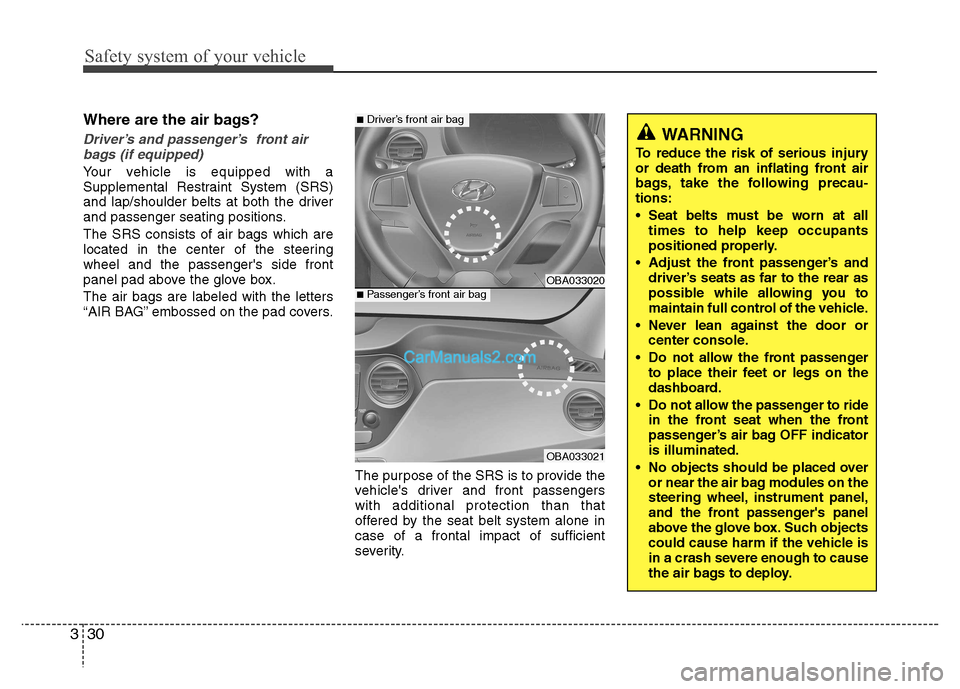
Safety system of your vehicle
30
3
Where are the air bags?
Driver’s and passenger’s front air
bags (if equipped)
Your vehicle is equipped with a
Supplemental Restraint System (SRS)
and lap/shoulder belts at both the driver
and passenger seating positions. The SRS consists of air bags which are
located in the center of the steeringwheel and the passenger's side front
panel pad above the glove box. The air bags are labeled with the letters
“AIR BAG” embossed on the pad covers.
The purpose of the SRS is to provide the
vehicle's driver and front passengerswith additional protection than that
offered by the seat belt system alone incase of a frontal impact of sufficient
severity.
WARNING
To reduce the risk of serious injury
or death from an inflating front air
bags, take the following precau-tions:
Seat belts must be worn at all times to help keep occupants
positioned properly.
Adjust the front passenger’s and driver’s seats as far to the rear as
possible while allowing you to
maintain full control of the vehicle.
Never lean against the door or center console.
Do not allow the front passenger to place their feet or legs on the
dashboard.
Do not allow the passenger to ride in the front seat when the front
passenger’s air bag OFF indicatoris illuminated.
No objects should be placed over or near the air bag modules on the
steering wheel, instrument panel,
and the front passenger's panel
above the glove box. Such objects
could cause harm if the vehicle is
in a crash severe enough to cause
the air bags to deploy.
OBA033020
OBA033021
■Driver’s front air bag
■Passenger’s front air bag
Page 43 of 343
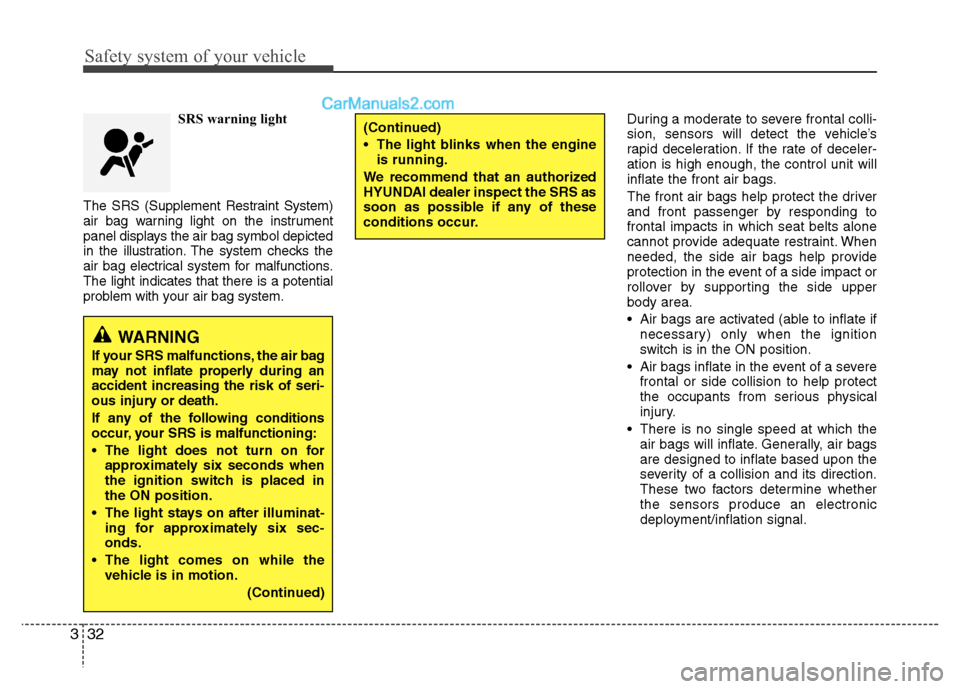
Safety system of your vehicle
32
3
SRS warning light
The SRS (Supplement Restraint System)
air bag warning light on the instrument
panel displays the air bag symbol depicted
in the illustration. The system checks the
air bag electrical system for malfunctions.The light indicates that there is a potential
problem with your air bag system. During a moderate to severe frontal colli-
sion, sensors will detect the vehicle’s
rapid deceleration. If the rate of deceler-ation is high enough, the control unit will
inflate the front air bags.
The front air bags help protect the driver
and front passenger by responding tofrontal impacts in which seat belts alone
cannot provide adequate restraint. When
needed, the side air bags help provide
protection in the event of a side impact or
rollover by supporting the side upperbody area.
Air bags are activated (able to inflate if
necessary) only when the ignition
switch is in the ON position.
Air bags inflate in the event of a severe frontal or side collision to help protect
the occupants from serious physical
injury.
There is no single speed at which the air bags will inflate. Generally, air bagsare designed to inflate based upon the
severity of a collision and its direction.
These two factors determine whetherthe sensors produce an electronic
deployment/inflation signal.
WARNING
If your SRS malfunctions, the air bag
may not inflate properly during anaccident increasing the risk of seri-
ous injury or death.
If any of the following conditions
occur, your SRS is malfunctioning:
The light does not turn on for approximately six seconds when
the ignition switch is placed inthe ON position.
The light stays on after illuminat- ing for approximately six sec-onds.
The light comes on while the vehicle is in motion.
(Continued)
(Continued)
The light blinks when the engineis running.
We recommend that an authorized
HYUNDAI dealer inspect the SRS as
soon as possible if any of these
conditions occur.
Page 44 of 343
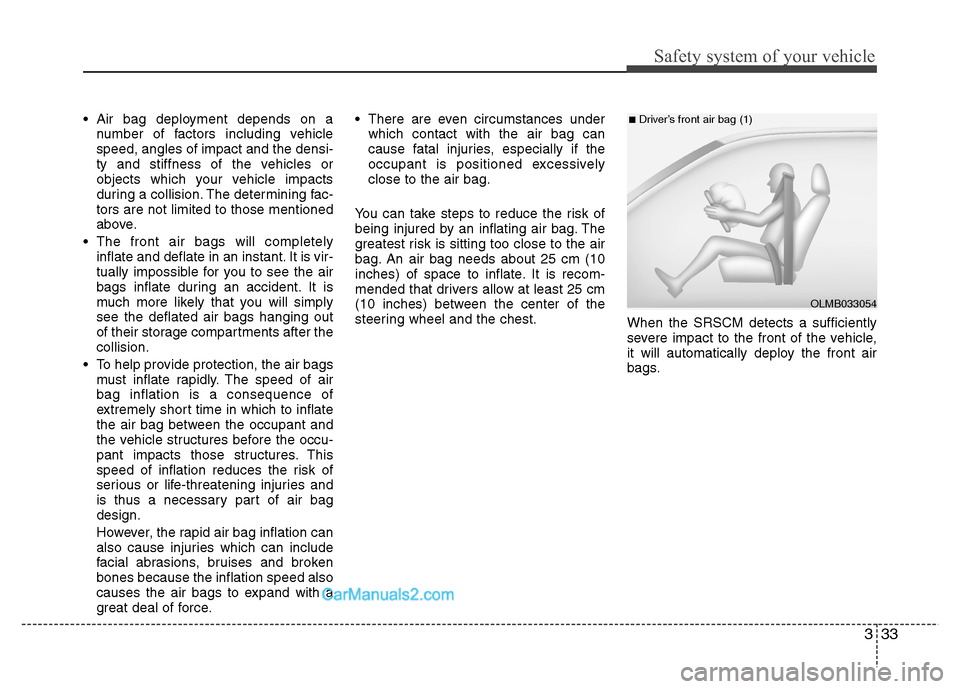
333
Safety system of your vehicle
Air bag deployment depends on anumber of factors including vehicle speed, angles of impact and the densi-
ty and stiffness of the vehicles or
objects which your vehicle impacts
during a collision. The determining fac-tors are not limited to those mentioned
above.
The front air bags will completely inflate and deflate in an instant. It is vir-
tually impossible for you to see the air
bags inflate during an accident. It is
much more likely that you will simplysee the deflated air bags hanging out
of their storage compartments after thecollision.
To help provide protection, the air bags must inflate rapidly. The speed of airbag inflation is a consequence of
extremely short time in which to inflate
the air bag between the occupant and
the vehicle structures before the occu-
pant impacts those structures. This
speed of inflation reduces the risk of
serious or life-threatening injuries and
is thus a necessary part of air bagdesign.
However, the rapid air bag inflation can
also cause injuries which can include
facial abrasions, bruises and brokenbones because the inflation speed also
causes the air bags to expand with a
great deal of force. There are even circumstances under
which contact with the air bag can
cause fatal injuries, especially if the
occupant is positioned excessivelyclose to the air bag.
You can take steps to reduce the risk of
being injured by an inflating air bag. The
greatest risk is sitting too close to the air
bag. An air bag needs about 25 cm (10
inches) of space to inflate. It is recom-
mended that drivers allow at least 25 cm
(10 inches) between the center of the
steering wheel and the chest. When the SRSCM detects a sufficiently
severe impact to the front of the vehicle,
it will automatically deploy the front air
bags.
OLMB033054
■Driver’s front air bag (1)